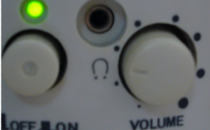There are way too many ways to control volume on modern computers. What are they and how do we use them?
Lucky for you I have donated hours of my precious time to find out the answer to this questions of utmost importance.
The topmost way of controlling volume can be found on your loudspeaker:
 This one is very easy to use; don't use it. Set it to about a quarter to half of it's capable volume and leave it there. Forever.
This one is very easy to use; don't use it. Set it to about a quarter to half of it's capable volume and leave it there. Forever.Actually there is one exception. In case of an emergency you may turn it down for a short time. An emergency may be if the sounds emited from the speaker are so high that your house might fall apart any second. In which case you should turn down the volume on the speaker to avoid total obliteration. As soon as the volume is survivable for more than 5 minutes, adjust the volume on another volume controller and set this one back to it's original.
This is the most dangerous way of controlling volume and it should only be used in rare occasions as the power of this controller can easily be misused. If you use this way of controlling volume too often you might become addicted to it's power. Don't join the dark side, they always lose (infact that's why they are the dark side).
The next lower level of controlling sound is on the system level:
 The above picture is from the Ubuntu operating system (the superior one). On Windows this volume controller can be found on the bottom right of the screen (it's this little icon desperately trying to imitate a speaker).
The above picture is from the Ubuntu operating system (the superior one). On Windows this volume controller can be found on the bottom right of the screen (it's this little icon desperately trying to imitate a speaker).The system volume controller should be set on a level which makes the system sounds sound good. Each system has it's own unique way of playing system sounds. In Ubuntu for example you could go to System>Preferences>Sound>Sounds(tab) to listen to various system sounds. For Windows you could wait for the occasional error to pop up. For a Macintosh you could repeatedly restart the system to listen to the beautiful starting up sound provided by the system.
Whichever way you choose, every time you hear a system sound, adjust the system volume controller a little until the system sounds have a reasonable volume which you like.
As in the previous controller, leave this controller alone once it's set to make system sounds sound reasonable. Don't even touch this one in an emergency, it's quicker to use a physical way of adjusting volume than a virtual one.
The lowest way of adjusting volume can be found on individual music/video players:
 The above picture is from the YouTube video player, and yes, they are also trying to imitate the beautiful speaker icon used in Ubuntu by rotating a UFO by 90 degrees.
The above picture is from the YouTube video player, and yes, they are also trying to imitate the beautiful speaker icon used in Ubuntu by rotating a UFO by 90 degrees.This way is the lowest way and that is why there are the most of them. Almost every respectable video/music player has one of these little volume controllers. This way is also the most used way of controlling volume. Every time you listen to a different movie/sound track you should adjust this volume controller to make the sound coming out of your speakers a reasonable volume. This is the most important way of controlling volume, use it.
Along with the above three ways of controlling volumes there are many more but they are too minuscule to mention here. They include: cloth in front of speaker, overclock speaker, drown speaker, earplugs, become deaf, increase distance between ears and speaker, and finally my favorite, decrease blood flow to brain.
With the above expertise you can become a master of volume =D
No comments:
Post a Comment